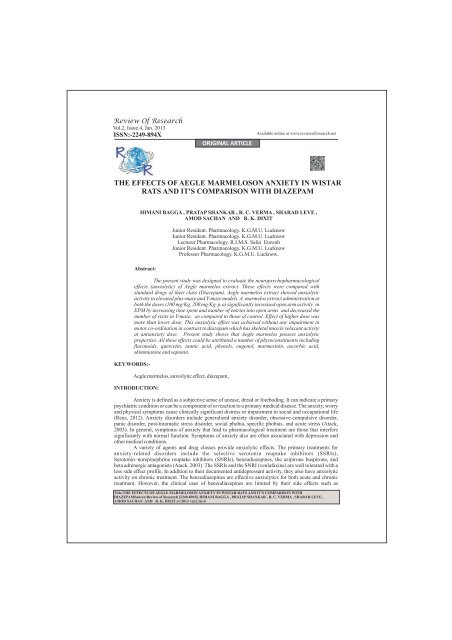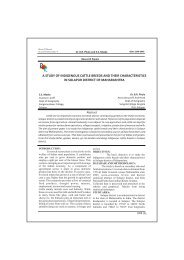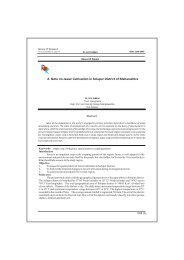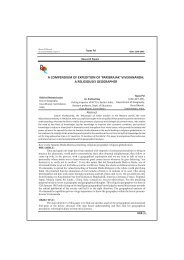HIMANI BAGGA - Review of Research Journal
HIMANI BAGGA - Review of Research Journal
HIMANI BAGGA - Review of Research Journal
You also want an ePaper? Increase the reach of your titles
YUMPU automatically turns print PDFs into web optimized ePapers that Google loves.
<strong>Review</strong> Of <strong>Research</strong>Vol.2, Issue.4, Jan. 2013ISSN:-2249-894XORIGINAL ARTICLEAvailable online at www.review<strong>of</strong>research.netTHE EFFECTS OF AEGLE MARMELOSON ANXIETY IN WISTARRATS AND IT'S COMPARISON WITH DIAZEPAMAbstract:KEY WORDS:-The present study was designed to evaluate the neuropsychopharmacologicaleffects (anxiolytic) <strong>of</strong> Aegle marmelos extract. These effects were compared withstandard drugs <strong>of</strong> their class (Diazepam). Aegle marmelos extract showed anxiolyticactivity in elevated plus-maze and Y-maze models. A. marmelos extract administration atboth the doses (100 mg/Kg, 200 mg/Kg, p.o) significantly increased open arm activity inEPM by increasing time spent and number <strong>of</strong> entries into open arms and decreased thenumber <strong>of</strong> visits in Y-maze, as compared to those <strong>of</strong> control. Effect <strong>of</strong> higher dose wasmore than lower dose. This anxiolytic effect was achieved without any impairment inmotor co-ordination in contrast to diazepam which has skeletal muscle relaxant activityat antianxiety dose. Present study shows that Aegle marmelos possess anxiolyticproperties. All these effects could be attributed a number <strong>of</strong> phytoconstituents includingflavonoids, quercetin, tannic acid, phenols, eugenol, marmesinin, ascorbic acid,skimmianine and saponin.Aegle marmelos, anxiolytic effect, diazepam,INTRODUCTION:<strong>HIMANI</strong> <strong>BAGGA</strong> , PRATAP SHANKAR , R. C. VERMA , SHARAD LEVE ,AMOD SACHAN AND R. K. DIXITJunior Resident. Pharmacology. K.G.M.U. LucknowJunior Resident. Pharmacology. K.G.M.U. LucknowLecturer Pharmacology. R.I.M.S. Safai EtawahJunior Resident. Pharmacology. K.G.M.U. LucknowPr<strong>of</strong>essor Pharmacology. K.G.M.U. Lucknow.Anxiety is defined as a subjective sense <strong>of</strong> unease, dread or foreboding. It can indicate a primarypsychiatric condition or can be a component <strong>of</strong> or reaction to a primary medical disease. The anxiety, worryand physical symptoms cause clinically significant distress or impairment in social and occupational life(Reus, 2012). Anxiety disorders include generalized anxiety disorder, obsessive-compulsive disorder,panic disorder, post-traumatic stress disorder, social phobia, specific phobias, and acute stress (Atack,2003). In general, symptoms <strong>of</strong> anxiety that lead to pharmacological treatment are those that interferesignificantly with normal function. Symptoms <strong>of</strong> anxiety also are <strong>of</strong>ten associated with depression andother medical conditions.A variety <strong>of</strong> agents and drug classes provide anxiolytic effects. The primary treatments foranxiety-related disorders include the selective serotonin reuptake inhibitors (SSRIs),Serotonin–norepinephrine reuptake inhibitors (SNRIs), benzodiazepines, the azipirone buspirone, andbeta adrenergic antagonists (Atack, 2003). The SSRIs and the SNRI (venlafaxine) are well tolerated with aless side effect pr<strong>of</strong>ile. In addition to their documented antidepressant activity, they also have anxiolyticactivity on chronic treatment. The benzodiazepines are effective anxiolytics for both acute and chronictreatment. However, the clinical uses <strong>of</strong> benzodiazepines are limited by their side effects such asTitle:THE EFFECTS OF AEGLE MARMELOSON ANXIETY IN WISTAR RATS AND IT'S COMPARISON WITHDIAZEPAMSource:<strong>Review</strong> <strong>of</strong> <strong>Research</strong> [2249-894X] <strong>HIMANI</strong> <strong>BAGGA</strong> , PRATAP SHANKAR , R. C. VERMA , SHARAD LEVE ,AMOD SACHAN AND R. K. DIXIT yr:2013 vol:2 iss:4
THE EFFECTS OF AEGLE MARMELOSON ANXIETY IN WISTAR RATS ........psychomotor impairment, potentiation <strong>of</strong> other central depressant drugs and dependence liability(Emamghoreishi et al., 2005). â adrenergic antagonists, particularly those with higher lipophilicity (e.g.,propranolol and nadolol) are occasionally used for performance anxiety such as fear <strong>of</strong> public speaking;their use is limited due to significant side effects such as hypotension.Now a days scientific interest in medicinal plants has burgeoned in recent times due to increasedefficiency <strong>of</strong> new plant derived drugs and rising concerns about the side effects <strong>of</strong> allopathic medicines.Aegle marmelos, commonly known as a bael, is one <strong>of</strong> the gifts <strong>of</strong> nature to mankind. Numerouspharmacological studies have been conducted on different parts <strong>of</strong> Aegle marmelos. This plant is havinggreat potential to cure the diseases like diabetes, hyperlipidemia, peptic ulcer, diarrhoea, dysentery, cancersetc. It has also shown its effect as cardio protective, anti bacterial, anti fungal, radio protective, anti pyretic,analgesic, antioxidant, hepatoprotective, and many more.However, there are only few studies <strong>of</strong> Aegle marmelos pertaining to central nervous systemactivities. Hence in the present study, Neuropsychopharmacological effects <strong>of</strong> Aegle marmelos (Bael)(including antidepressant, nootropic, anxiolytic, analgesic activities and effect on motor function) werestudied in wistar rats.Anxiety disorders, the most prevalent psychiatric illnesses in the general community, are presentin 15–20% <strong>of</strong> medical clinic patients. Anxiety, defined as a subjective sense <strong>of</strong> unease, dread, or foreboding,can indicate a primary psychiatric condition or can be a component <strong>of</strong> or reaction to a primary medicaldisease. The principal components <strong>of</strong> anxiety are psychological (tension, fears, difficulty in concentration,apprehension) and somatic (tachycardia, hyperventilation, palpitations, tremor, sweating). Other organsystems (eg, gastrointestinal) may be involved in multiple-system complaints. Fatigue and sleepdisturbances are common (Reus, 2012).MATERIALS AND METHODSThe study was conducted in the Department <strong>of</strong> Pharmacology and Therapeutics, King George'sMedical University, Lucknow (Erstwhile Chhatrapati Shahuji Maharaj Medical University). Ethicalclearance was obtained from the Institutional Animal Ethics Committee before conducting the study.EXPERIMENTAL ANIMALS & REARING CONDITIONSAdult healthy Male Wistar rats weighing 160-200 gm had been used in study. Animals had beenobtained from CPCSEA-certified animal house [Indian Institute <strong>of</strong> Toxicology <strong>Research</strong>, Lucknow(IITR)]. They were allowed to access normal rat pellet diet and water ad libitum and were kept inInstitutional animal house under temperature controlled environment [25 ± 2°C] with 12 hours' light anddark cycle. The animals were housed for two weeks prior to the experiments to acclimatize to newenvironment.The maintenance <strong>of</strong> the animals and the experimental procedures were in accordance with theguiding principles <strong>of</strong> Institutional Animal Ethics committee and the 'Guide for the Care and Use <strong>of</strong>Laboratory Animals', National <strong>Research</strong> Council, 1996 (Latest revision in 2011). The guidelines <strong>of</strong>Committee for the Purpose <strong>of</strong> Control and Supervision <strong>of</strong> Experiments on Animals (CPCSEA), Govt. <strong>of</strong>India were followed.Dosage Forms, Doses and Sources <strong>of</strong> the DrugsFollowing drugs were used in this study.(1)Test Drugs - Bael (Aegle marmelos)- Drug (extract form) was dissolved in normal saline andadministered orally with the help <strong>of</strong> feeding cannula in a doses <strong>of</strong> 100 mg/ kgbw and 200 mg/ kgbw(Shankharananth, 2007). It was purchased from market (Aegle marmelos extract, Himalaya DrugCompany).(2)Standard drugs - Diazepam : Dose 2 mg/kgbw i.p. (Sujith et al., 2011; Kumar et al, 2011). Tablets werepurchased from government authorized medical store.EXPERIMENTAL PROTOCOL -The present study had been designed to evaluate Neuropsychopharmacological effects <strong>of</strong> Aeglemarmelos (Bael) that includes anxiolytic in male wistar rats.<strong>Review</strong> Of <strong>Research</strong> * Volume 2 Issue 4 * Jan 20132
THE EFFECTS OF AEGLE MARMELOSON ANXIETY IN WISTAR RATS ........Animal GroupsA total number <strong>of</strong> 24 Male Wistar rats were included in the study. They were kept in InstitutionalAnimal House under standard conditions. All the animals received normal rat pellet diet and water adlibitum. All the animals were allowed to get acclimatised to the new environment for period <strong>of</strong> 2 weeks.Rats were randomly divided in to 4 groups, each group containing 6 rats: all groups were used toevaluate the effect <strong>of</strong> Aegle marmelos on learning and memory and its comparison with that <strong>of</strong> piracetam.Three weeks after the evaluation <strong>of</strong> effect on learning and memory, all groups were used to evaluate theeffects <strong>of</strong> Aegle marmelos on anxiety. The effects were compared with those <strong>of</strong> diazepam.Neuropsychopharmacological EvaluationAdult male Albino Wistar rats weighing between 160- 200 gms were used. All the animals allowedto get to acclimatize to the new environment for period <strong>of</strong> 2 weeks. They were provided with normal ratpellet diet & water ad libitum.Following validated behavioural models <strong>of</strong> rodents were used to assess theneuropsychopharmacological effects <strong>of</strong> Aegle marmelous extract.Assessment <strong>of</strong> Anxiotytic Activity in ratsBy Elevated plus maze (EPM) model:Grouping:Albino Wistar rats weighing between 160- 200 gms were randomly divided into 4 groups, each groupcontaining 6 rats.Group 1: Rats were administered normal saline p.o (1 ml)Group 2: Rats were administered aegle marmelous extract (100 mg/kg) p.o.Group 3: Rats were administered aegle marmelous extract (200 mg/kg) p.o.Group 4: Rats were administered standard drug Diazepam (2 mg/kg) i.p.PROCEDURE:The elevated plus-maze model is well established animal model for testing anxiolytic drugs(Pellow et al., 1985). The elevated plus-maze is based on two conflicting tendencies; the rodents drive toexplore a novel environment and its aversion to heights and open spaces. The plus-maze apparatusconstructed <strong>of</strong> wood consisting <strong>of</strong> two open arms (40 x 10 cm) and two closed arms (40 x 10 cm x 41) and acentral platform (10 cm×10 cm), arranged in such a way that the two arms <strong>of</strong> each type were opposite toeach other to give the apparatus a plus sign appearance. The entire maze was elevated to a height <strong>of</strong> 50 cmabove the floor (Kulkarni and Reddy, 1996; Vogel and Vogel, 1997).Animals were brought to the testing room 1 hr prior to testing. Each rat was placed at the centre <strong>of</strong>the elevated plus maze with its head facing the open arms. The dose administration schedule was soadjusted that each rat was having its turn on the elevated plus-maze apparatus 30 min after diazepam (2mg/Kg, i.p.) and 60 min after the oral administration <strong>of</strong> the extracts doses and vehicle.Each rat was observed for a total <strong>of</strong> 5 minutes at approximately 2 m distance from the apparatus.Entry into an arm was defined as the point when the animal places all four paws onto the arm. Time wasrecorded with the help <strong>of</strong> stop watch.During the entire experiment, (Kulkarni , 2002), every precaution was taken to ensure that noexternal stimuli, other than the height <strong>of</strong> plus-maze could invoke anxiety in the animals.Room level lighting was kept consistent during all trials.The procedure was conducted in a sound attenuated room.The apparatus was cleaned thoroughly between trials to eliminate the possible bias due the odour left by theprevious animal.Assessment:During the 5 min experiment, following behavior <strong>of</strong> the rats was recorded (Pellow et al., 1985;Saivasanthi et al., 2011);Number <strong>of</strong> entries into the open armNumber <strong>of</strong> entries into the closed arm<strong>Review</strong> Of <strong>Research</strong> * Volume 2 Issue 4 * Jan 20133
THE EFFECTS OF AEGLE MARMELOSON ANXIETY IN WISTAR RATS ........treatment effect (baseline compared with follow-ups) as a within-subject factor. A significant P value forthe treatment effect indicated a change over time in the combined values <strong>of</strong> the groups and was furtherinvestigated by using a paired t test for each individual group. Between group differences in treatmenteffect were indicated by significant interactions between treatment effect and treatment type. The percentchange from baseline to follow-ups was also calculated for each group. Statistical significance was basedon a two-tailed P value < 0.05.OBSERVATIONS AND RESULTSAssessment <strong>of</strong> Antianxiety ActivityBy Elevated plus maze (EPM) model:The antianxiety effect on different treatment group (Group 1: Control, Group 2: Aegle marmelousextract 100 mg/kg, Group 3: Aegle marmelous extract 200 mg/kg, Group 4: Diazepam 2 mg/kg) have beensummarized in Table-1. The time spent in open and close arm was 60.00±5.86 and 200.00±8.46respectively in Group 1. The percentage <strong>of</strong> total time spent in open arm was 23% in Group 1. Almost similarobservation was found for Group 2, 3 and 4. The %age <strong>of</strong> total time spent in open arm was higher in Group 4than Group 3 (32%), Group 2 (30%) and Group 1 (23%).Table 8a: Effect <strong>of</strong> Aegle marmelous extract on Time spent in different arms (ELEVATEDPLUS MAZE):Groups Time spent Percentage <strong>of</strong> total timespentOpen armClose arm Open arm Close arm(Mean±SD)(Mean±SD)Group 9 60.00±5.86 200.00±8.46 23.0 76.9Group 10 75.17±6.07 174.83±4.35 30.0 69.9Group 11 85.19±6.02 170.17±5.99 32.0 67.9Group 13 105.00±5.25 144.83±3.65 42.0 57.9The average no. <strong>of</strong> entries in open and close arm was 2.00±0.90 and 9.50±1.04 respectively inGroup 1. Almost similar observation was found for Group 2, 3 and 4. The percentage <strong>of</strong> open arm entrieswas higher in Group 4 (44.9%) than Group 3 (39.1%), 2 (28.8%) and 1 (17%) (Table-2).Table 2: Effect <strong>of</strong> Aegle marmelous extract on No. <strong>of</strong> entries in different arms(ELEVATED PLUS MAZE):Groups No <strong>of</strong> entries (Mean±SD) Percentage <strong>of</strong> entriesOpen arm Close arm Open arm Close armGroup 1 2.00±0.90 9.50±1.04 17.0 82.9Group 2 3.67±0.82 9.00±0.90 28.8 71.1Group 3 5.50±1.04 8.50±1.04 39.1 60.8Group 4 9.00±0.89 11.0±0.89 44.9 55.0* Statistically significantThe time spent was significantly different between Group 1 and 2 (p
THE EFFECTS OF AEGLE MARMELOSON ANXIETY IN WISTAR RATS ........GroupsTable 3: Comparison <strong>of</strong> antianxiety activity (ELEVATED PLUS MAZE) between groupsTime spentNo. <strong>of</strong> entriesOpen arm Close arm Open arm Close armMean d/f p-value Mean d/f p-value Mean d/f p-value Mean d/f p-valueGroup 10 15.17
THE EFFECTS OF AEGLE MARMELOSON ANXIETY IN WISTAR RATS ........plants have been being used for management <strong>of</strong> mental illness. Some <strong>of</strong> them are as follows:For treatment <strong>of</strong> anxiety- Bacopa monniera (kumar, 2006), Citrus paradise (Gupta et al., 2010),Azadirachta indica, Centella asiatica;For treatment <strong>of</strong> depression- Allium cepa (Sakakibara et al., 2008), Bacopa monniera (Sairam etal., 2002), Centella asiatica (Rajput et al., 2011) , Curcuma longa ( Yu et al., 2002);For improving learning and memory- Ginkgo biloba, Glycyrrhiza glabra, Piper longum, Bramhi,Shatavari, Shankhapushpi.Several active constituents, which can be <strong>of</strong> immense importance as drugs, are the precursors forsynthesis <strong>of</strong> many drugs (Dhankhar and Ruhil, 2011). Their effectiveness, low cost and comparativefreedom from serious toxic effects make these medicines not only popular but also an acceptable mode <strong>of</strong>treating diseases even in modern times. Due to the various unavoidable adverse effects <strong>of</strong> availableallopathic medicines, management <strong>of</strong> various diseases without any untoward side effects is still a challengefor modern medical science. So several herbal plants having various bioactive phytochemicals, possessingseveral activities and no or very less adverse effects, have been explored.Number <strong>of</strong> studies have shown beneficial effects <strong>of</strong> Aegle marmelos as antiviral, antibacterial,antifungal, anticancer, antihyperlipidemic, antidiabetic and antioxidant agents. However, there are onlyfew studies pertaining to neuropsychopharmacological actions <strong>of</strong> Aegle marmelos. Manyphytoconstituents like flavonoids, saponins, quercetin, phenols, skimmianine and ascorbic acid haveshown very important role in management <strong>of</strong> psychiatric illnesses. The herbal plants which are used fortreatment <strong>of</strong> various psychiatric illnesses in traditional medicines contains these phytoconstituents.Phytochemical screening <strong>of</strong> Aegle marmelos have shown the presence <strong>of</strong> many phytoconstituentsincluding flavonoids, saponins, quercetin, phenols, skimmianine and ascorbic acid (Patel and Sahu, 2012).Hence, we hypothesised that, due to the presence <strong>of</strong> these important phytoconstituents similar to the otherherbal plants being used for many psychiatric illnesses, Aegle marmelos could have the potential place intreatment <strong>of</strong> such type <strong>of</strong> illnesses.The present study was undertaken to explore the Neuropsychopharmacological effects <strong>of</strong> Aeglemarmelos (Bael) that includes anxiolytic in wistar rats.The dose <strong>of</strong> Aegle marmelos was based on previous studies (Shankharananth, 2007). Extract formneeds less amount to be administered, previous trials and experimental studies have been mostly performedusing extract (ethanolic or aqueous) forms and also they are soluble in normal saline. Therefore we havechosen the extract-form in our study.We have chosen the oral route for administering the herbs as a drug, as this route is natural & usualroute <strong>of</strong> taking herbal drugs if prescribed by a physician. This route doesn't need assistance <strong>of</strong> others and isquite easy in terms <strong>of</strong> intake.A total number <strong>of</strong> 24 male Wistar rats were included in the study. Rats were randomly divided in to 4groups, each group containing 6 rats. All the animals were allowed to get acclimatised to the newenvironment for period <strong>of</strong> 2 weeks. All group were used to evaluate the effect <strong>of</strong> Aegle marmelos onlearning, memory and anxiety.Antianxiety activity <strong>of</strong> A. marmelos in rats was assessed by Elevated Plus-Maze model. Theelevated plus-maze model is based on two conflicting tendencies; the rodents drive to explore a novelenvironment and its aversion to heights and open spaces. Each rat was given the choice <strong>of</strong> spending time inopen, unprotected maze arms or enclosed, protected arms. Animals tend to avoid the open areas, especiallywhen they are brightly lit, favouring darker, more enclosed spaces. Thus “anxious” animals spent most <strong>of</strong>the time in the closed arms while less anxious animals explored open areas longer.Administration <strong>of</strong> classic anxiolytic benzodiazepines and other anxiolytic treatments results inincreased exploration <strong>of</strong> the open arms. These results confirm the suitability <strong>of</strong> the method used in thepresent study, and agree with previous literature data (Wolfman et al., 1994; Yasumatsu et al., 1994; Lister,1987).Results <strong>of</strong> present study showed anxiolytic activity <strong>of</strong> Aegle marmelos in elevated plus-mazemodel as well as Y-maze model. Aegle marmelos extract administration at both the doses significantlyincreased open arm activity by increasing time spent and number <strong>of</strong> entries into open arms when comparedwith control. Higher dose <strong>of</strong> Aegle marmelos extract (200 mg/kg p.o) showed more percentage increase inopen arm activity, but less than Diazepam (Table 1, 2, 3). In Y maze, there was significant decrease in visitsat both doses. Higher dose shows more decrease, but less than standard (Table 4, 5). The results wereconsistent with previous study (Kothari et al., 2010).Apart from main neurotransmitters, such as monoamines (dopamine, noradrenaline andserotonin), gamma-amino-butyric acid (GABA) and glutamate, many other modulators like neuropeptides(galanin, neuropeptide Y, arginine vasopressin, tachykinin and substance P), neurosteroids and cytokineshave been observed to play a modulators role in anxiety states (Anusha et al., 2012; Gilhotra and Dhingra<strong>Review</strong> Of <strong>Research</strong> * Volume 2 Issue 4 * Jan 20137
THE EFFECTS OF AEGLE MARMELOSON ANXIETY IN WISTAR RATS ........REFERENCES:1.Anusha K, Clement Atlee W, Balakrishna P. The Anxiolytic effect <strong>of</strong> Ethanolic extract <strong>of</strong> AegleMarmelos fruits in Mice. Int.J.Ph.Sci., Jan-April,2012;4(1): 1813-18232.Charoensiddhi S. and Anprung P. Bioactive compounds and volatile compounds <strong>of</strong> Thai bael fruit(Aeglemarmelos (L.) Correa) as a valuable source for functional food ingredients. International Food<strong>Research</strong> <strong>Journal</strong> 15(3): 287-295 (2008).3.Desai Nilesh V, Patkar Atul A, Shinde Shilpa S, Arwade Aboli S. Protective effect <strong>of</strong> aqueous extract <strong>of</strong>Aegle marmelos against formaldehyde induced arthritis in rats. Int. Res J Pharm. App Sci., 2012;2(4):66-724.Dhankhar Sandeep, Ruhil S, et al, Aegle marmelos Correa: A Potential Source <strong>of</strong> Phytomedicine. <strong>Journal</strong><strong>of</strong> Medicinal plant <strong>Research</strong> 2011, 5(9):1497-1507.5.Emamghoreishi M, Khasaki M, Aazam MF. Coriander sativum: evaluation <strong>of</strong> its anxiolytic effect in theelevated plus-maze. J. Ethnopharmacol., 2005; 96:365-70.6.Gilhotra N and Dhingra D, Neurochemical Modulation Of Anxiety Disorders, International <strong>Journal</strong> <strong>of</strong>Pharmacy and Pharmaceutical Sciences Vol 2, Suppl 1, 20107.Griebel G ., Perrault G . , Tan S ., Schoemaker H . and Sanger D.J., Pharmacological studies on syntheticflavonoids: comparison with diazepam, Neuropharmacol., 1999, 38, 965.8.Kothari Saroj, Minda Manish And Tonpay S D. ANXIOLYTIC AND ANTIDEPRESSANTACTIVITIES OF METHANOL EXTRACT OF AEGLE MARMELOS LEAVES IN MICE. Indian JPhysiol Pharmacol 2010; 54 (4) : 318–3289.Kulkarni SK, Reddy DS. (1996). Animal behavioral models for testing antianxiety activity. Method FindExperiment Clinical Pharmacology 18, 219-240.10.Kulkarni S.K., Animals Behavioral Models for Testing Anti-Anxiety Agents, In: Hand book <strong>of</strong>Experimental Pharmacology, 3rd edition, VallabhPrakashan, Delhi, 2002, 27-37.11.Kumar S, Joseph L, George M, Kaur L, Bharti V. Skeletal muscle relaxant activity <strong>of</strong> methanolic extract<strong>of</strong> Rumex nepalensis in albino rats. J. Chem. Pharm. Res., 2011, 3(3):725-728.12.kumar V, Potential plants for CNS disorders: an overview, Phytother. Res, 2006, 20(12), 1023-1035.13.Lister RG (1987). The use <strong>of</strong> plus-maze to measure anxiety in the mouse. Psychopharmacology, 92:180-185.14.Mahe M, Driessche JV, Girre L. Pharmacological properties <strong>of</strong> several indigenous plants on the nervoussystem. Plant Med Phytother1978; 12: 248-258.15.Medina JH, Viola H, Wolfman C, Marder M, Wasowski C, Clavo D, Paladini AC. Neuroactiveflavonoids: new ligands for the benzodiazepine receptors. Phytomed.1997; 5: 235-243.16.Millan MJ, The neurobiology and control <strong>of</strong> anxious states, ProgNeurobiol, 2003 Jun;70(2):83-244.17.Monique V, Willy M, Francoise D, Michel LM, Herve S, and Stefania M, Prenatal stress induces highanxiety and postnatal handling induces low anxiety in adult <strong>of</strong>fspring: correlation with stress inducedcorticosterone secretion. The <strong>Journal</strong> <strong>of</strong> Neuroscience, 2626-2636, (1997).18.Paladini AC, Marder M, Viola H, Wolfman C, Wasowaki C and Medina JH. Flavonoids and the centralnervous system: from forgotten factors to potent anxiolytic compounds. J. Pharm. Pharmacol.1999; 51:519-526.19.Patel Pushpendra K., Sahu Jyoti; Aegle marmelos:A <strong>Review</strong> on its Medicinal Properties; International<strong>Journal</strong> <strong>of</strong> Pharmaceutical and Phytopharmacological <strong>Research</strong>; 2012, 1(5): 332-341.20.Pellow S., Chopin P., File S.E. and Briley M.,Validation <strong>of</strong> open: closed arm entries in anelevated plusmazeas a measure <strong>of</strong> anxiety in therats, J. Neurosci., 1985, 14, 149-167.21.Rajput MS, Sinha S, Mathur V, Agrawal P. Herbal Antidepressants. International <strong>Journal</strong> <strong>of</strong>Pharmaceutical Frontier <strong>Research</strong> April-June 2011; 1(1):159-169.22.Ramprasath VR, Shanthi P. Anti-inflammatory effect <strong>of</strong> Samecarpus Anacardium nut extract in acuteand chronic inflammatory conditions, Biol Pharmaceutical Bulletine, 2004; 27(12): 2028-2031.23.Reus VI. Mental Disorders. In Harrison's Principles <strong>of</strong> Internal Medicine 18th ed. (Longo DL, KasperDL, Jameson JL, Fauci AS, Hauser SL, Loscalzo J, editors) McGraw Hill, New York. 2012. pp. 3520-3545.24.Sairam K, Dorababu M, Goel RK, Bhattacharya SK. Antidepressant activity <strong>of</strong> standardized extract <strong>of</strong>Bacopamonniera in experimental models <strong>of</strong> depression in rats. Phytomedicine 2002;9:207-11.25.Sakakibara H, Yoshino S, Kawai Y, Terao J. Antidepressant-like effect <strong>of</strong> onion (Allium cepa L.) powderin a rat behavioral model <strong>of</strong> depression. BiosciBiotechnolBiochem 2008;72:94-100.26.Shankarnanth V., Balakrishnan N., Suresh D., Sureshpandian G., Edwin E. and Sheeja E. (2007),“Analgesic activity <strong>of</strong> methanol extract <strong>of</strong> Aegle marmelos leaves”, Fitoterapia, Vol-78, Issue 3, Page No.258-259.27.Sharma GN., Dubey SK., Sati N, Sanadya J, Anti-inflammatory Activity and Total Flavonoid Content <strong>of</strong><strong>Review</strong> Of <strong>Research</strong> * Volume 2 Issue 4 * Jan 20139
THE EFFECTS OF AEGLE MARMELOSON ANXIETY IN WISTAR RATS ........Aeglemarmelos Seeds, International <strong>Journal</strong> <strong>of</strong> Pharmaceutical Sciences and Drug <strong>Research</strong> 2011; 3(3):214-218.28.Sieghart W. Pharmacology <strong>of</strong> benzodiazepine receptors: an update. J Psychiatry Neurosci 1994; 19:24–29.29.Sivraj R, Balakrishnan A. Preliminary phytochemical analysis <strong>of</strong> Aegle marmelos, International <strong>Journal</strong><strong>of</strong> Pharmaceutical Sciences and <strong>Research</strong>, 2011; 2(1): 146-150.30.Sujith K, Suba V, and Ronald Darwin C, NEUROPHARMACOLOGICAL PROFILE OFETHANOLIC EXTRACT OF ANACYCLUS PYRETHRUM IN ALBINO WISTAR RATS, International<strong>Journal</strong> Of Pharmaceutical Science And <strong>Research</strong> 2011; Vol. 2(8): 2109-2114.31.The guidelines <strong>of</strong> Committee for the Purpose <strong>of</strong> Control and Supervision <strong>of</strong> Experiments on Animals(CPCSEA), Govt. <strong>of</strong> India32.Vogel HG, Vogel WH. (1997). Drug Discovery and Evaluation. Springer Verlag, Heidelberg Germany,pp 378-379.33.Wolfman C, Viola H, Paladini A, Dajas F, Medina JH. Possible anxiolytic effects <strong>of</strong> chrysin, a centralbenzodiazepine receptor ligand isolated from Passiflora coerulea. Pharmacol. Biochem. Behav.1994; 47:1-4.34.Yasumatsu H, Morimoto Y, Yamamoto Y, Takehara S, Fukuda T, Nakao T & Setoguchi M (1994). Thepharmacological properties <strong>of</strong> Y-23684, a benzodiazepine receptor partial agonist. British <strong>Journal</strong> <strong>of</strong>Pharmacology, 111: 1170-1178.35.Yu ZF, Kong LD, Chen Y. Antidepressant activity <strong>of</strong> aqueous extracts <strong>of</strong> Curcuma longa in mice. JEthnopharmacol 2002;83:161-165.<strong>Review</strong> Of <strong>Research</strong> * Volume 2 Issue 4 * Jan 201310





